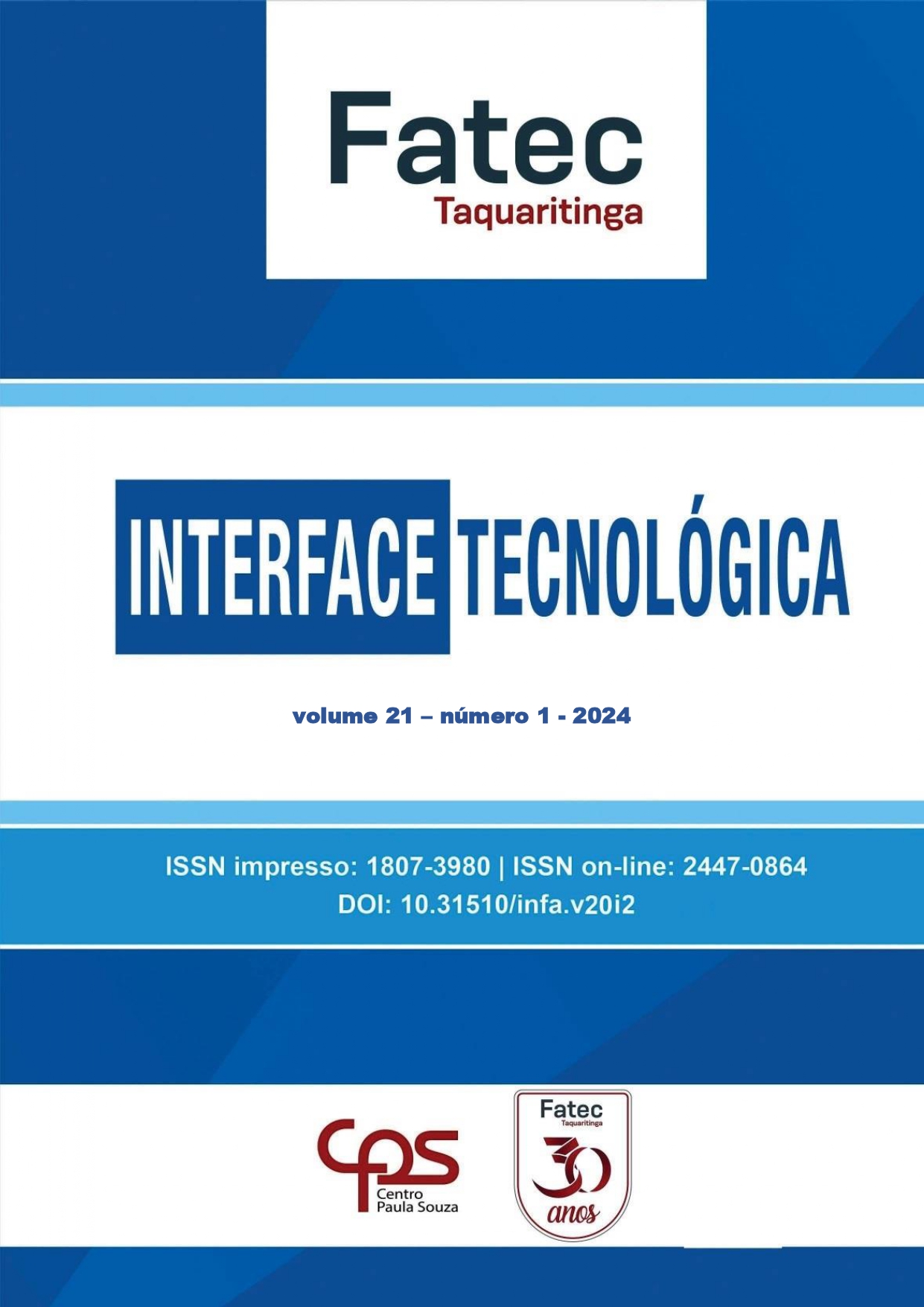BRAZILIAN AGROFORESTS
DOI:
https://doi.org/10.31510/infa.v21i1.1884Keywords:
Agroflorestas. Sistemas Florestais. Ecossistemas.Abstract
The objective of this research is to provide a comprehensive framework for a literature review on Brazilian agroforestry, addressing economic, environmental, social and cultural aspects of these agricultural systems. The descriptive methodology of bibliographic nature was adopted, where the theme of agroforestry was deepened, seeking agroforestry systems, the types and benefits of agroforestry and what are the future perspectives in relation to this system. Forest systems, which integrate agricultural crops, trees and other natural elements. Where it was possible to conclude that, Brazilian agroforestry represents not only a way of producing food, but also a tangible manifestation of our commitment to the harmony between agriculture and nature, thus ensuring a more prosperous and equitable future for present and future generations. The benefits of agroforestry are vast and multifaceted. In addition to increasing the resilience of agricultural systems to climate change and extreme events, agroforestry contributes to the conservation of biodiversity, the restoration of degraded soils, the protection of water resources, and the promotion of food and nutrition security for rural communities.
Downloads
References
ALVES, Denis Fernandes; DE ALENCAR, Matheus Oliveira. A exploração do sistema agroflorestal e potencialização do desenvolvimento local: um estudo de caso de Caririaçu/CE. Latin American Journal of Business Management, v. 11, n. 1, 2020. Disponível em: <https://lajbm.com.br/index.php/journal/article/view/593/276>. Acesso em: 20 mar. 2024.
ALVES, Jerusa Cariaga et al. Sistemas agroflorestais biodiversos: segurança alimentar e bem-estar às famílias agricultoras. Revista GeoPantanal, v. 14, n. 26, p. 75-94, 2019. Disponível em: <https://periodicos.ufms.br/index.php/revgeo/article/view/9351>. Acesso em: 28 fev. 2024.
CAMARGO, Giseli Mendonça et al. Sistemas agroflorestais biodiversos: uma alternativa para pequenas propriedades rurais. Revista Brasileira de Gestão e Desenvolvimento Regional, v. 15, n. 1, 2019. Disponível em
https://www.rbgdr.net/revista/index.php/rbgdr/article/view/4318/740. Acesso em: 20 mar. 2024.
CANUTO, Joao Carlos et al. Sistemas agroflorestais: experiências e reflexões. 2017. Disponível em: <https://www.alice.cnptia.embrapa.br/alice/handle/doc/1074707>. Acesso em: 02 mar. 2024.
COSTA PROENÇA, Lucio. Cultivando regeneração: a lógica econômica em agroflorestas sucessionais. 2023. Disponível em: <https://ddd.uab.cat/pub/revibec/revibec_a2023vpdf>. Acesso em: 02 mar. 2024.
DOS SANTOS, Wanderson Moreira et al. Sistema agroflorestal na agricultura familiar. Revista UFG, v. 20, 2020. Disponível em: DOI: https://doi.org/10.5216/revufg.v20.63772
<https://revistas.ufg.br/revistaufg/article/view/63772/36100>. Acesso em: 01 mar. 2024.
EWERT, Martin et al. Sistemas agroflorestais multiestrata e a legislação ambiental brasileira: desafios e soluções. Desenvolvimento e Meio ambientes, v. 36, p. 95-114, 2016. Disponível em:<https://biblioteca.incaper.es.gov.br/digital/bitstream/123456789/3957/1/Incaper-em-Revista-2019.pdf >Acesso em: 14 fev. 2024. DOI: https://doi.org/10.5380/dma.v36i0.39944
GUIMARÃES, LA de OP; MENDONÇA, G. C. Agricultura sintrópica (agrofloresta sucessional): fundamentos e técnicas para uma agricultura efetivamente sustentável. Incaper em revista, Vitória, v. 10, p. 6-21, 2019.Disponivel em: <https://biblioteca.incaper.es.gov.br/digital/bitstream/Incaper-em-Revista-2019.pdf> Acesso em: 03 mar. 2024.
MARTINS, Carlos Roberto et al. Fruticultura agroflorestal. 2022. Disponível em:
<https://ainfo.cnptia.embrapa.br/digital/bitstream/doc/1149594/1/CPACT-Doc-527-pag-18.pdf>. Acesso em: 20 fev. 2024.
MARTINS, Eline Matos et al. O uso de sistemas agroflorestais diversificados na restauração florestal na Mata Atlântica. Ciência Florestal, v. 29, p. 632-648, 2019. Disponível em: DOI: https://doi.org/10.5902/1980509829050
<https://www.scielo.br/j/cflo/a/69Wm8Q5W3HhMpKMK8MnxqXR/?format=html&lang=pt#>. Acesso em: 12 mar. 2024.
MARTINS, Tatiana Parreiras; RANIERI, Victor Eduardo Lima. Sistemas agroflorestais como alternativa para as reservas legais. Ambiente & Sociedade, v. 17, p. 79-96, 2014. Disponível em: <https://www.scielo.br/j/asoc/a/PTxQk86pRxYttphMQpG8L9x> Acesso em: 15 mar. 2024. DOI: https://doi.org/10.1590/S1414-753X2014000300006
MAZUCATO, Thiago et al. Metodologia da pesquisa e do trabalho científico. Penápolis: Funepe, 2018. Disponível em:
<https://edisciplinas.usp.br/pluginfile.php/5324848/mod_resource/content/1/Metodologia-MAZUCATO%28Org%29.pdf.> Acesso em: 15 mar. 2024.
MAPA- Ministério da Agricultura, Pecuária e Abastecimento. Ações para consolidação da Política Agrícola-Florestal Brasileira. Disponível em:
<https://www.gov.br/agricultura/pt-br/assuntos/noticias/ministros-favaro-e-waldez-avancam-em-projetos-da-agricultura-para-combater-as-desigualdades-sociais>. Acesso em: 21 mar. 2024.
MIRA, Pamela Mattar. Desafios e perspectivas na comercialização de produtos provenientes de sistemas agroflorestais no estado de São Paulo. 2021. Disponível em:
<https://repositorio.ufscar.br/handle/ufscar/13871?show=full>. Acesso em: 10 mar. 2024
MÜLLER, Marcelo Dias et al. Equações de altura, volume e afilamento para eucalipto e acácia estabelecidos em sistema silvipastoril. floresta, [S.l.], v. 44, n. 3, p. 473-484, mar. 2014. ISSN 1982-4688. Disponível em: <https://revistas.ufpr.br/floresta/article/view/33149>. Acesso em: 30 mar. 2024. doi:http://dx.doi.org/10.5380/rf.v44i3.33149. DOI: https://doi.org/10.5380/rf.v44i3.33149
OLIVEIRA, Larissa et al. Agrofloresta e seus benefícios salientando as vantagens ambientais. In: Congresso Brasileiro de Gestão Ambiental. 2018. p. 1-8. Disponível em:
<https://www.ibeas.org.br/congresso/Trabalhos2018/VII-038.pdf>. Acesso em: 12 mar. 2024.
PRODANOV, Cleber Cristiano; DE FREITAS, Ernani Cesar. Metodologia do trabalho científico: métodos e técnicas da pesquisa e do trabalho acadêmico-2ª Edição. Editora Feevale, 2013.
RIGHI, Ciro Abbud; BERNARDES, Marcos Silveira. Sistemas Agroflorestais: definição e perspectivas. Cadernos da Disciplina de Sistemas Agroflorestais, v. 1, p. 1-5, 2015. Disponível em: <https://www.esalq.usp.br/biblioteca/pdf/Cadernos-da-Disciplina-SAFs-2015.pdf>. Acesso em: 30 mar. 2024.
SCHEMBERGUE, Altamir et al. Sistemas Agroflorestais como Estratégia de Adaptação aos Desafios das Mudanças Climáticas no Brasil 2. Revista de Economia e Sociologia Rural, v. 55, p. 9-30, 2017. Disponível em: DOI: https://doi.org/10.1590/1234-56781806-94790550101
<https://www.scielo.br/j/resr/a/Wh4yNYqTzKtYhXXST8QFCTF/#> Acesso em: 17 fev. 2024.
Downloads
Published
Issue
Section
License
Copyright (c) 2025 Revista Interface Tecnológica

This work is licensed under a Creative Commons Attribution 4.0 International License.
Os direitos autorais dos artigos publicados pertencem à revista Interface Tecnológica e seguem o padrão Creative Commons (CC BY 4.0), que permite o remixe, adaptação e criação de obras derivadas do original, mesmo para fins comerciais. As novas obras devem conter menção ao(s) autor(es) nos créditos.








.jpg)




1.png)
1.png)
